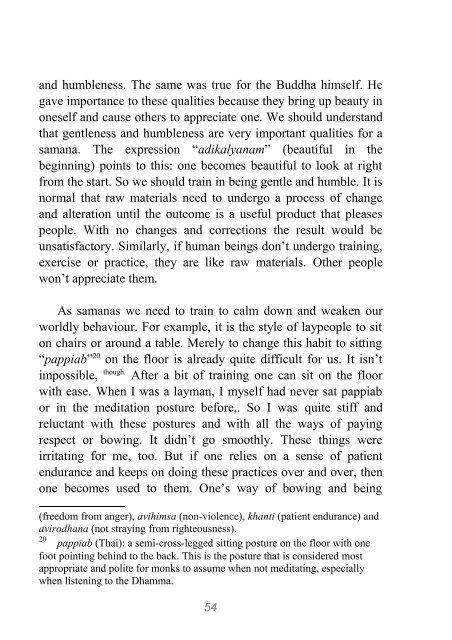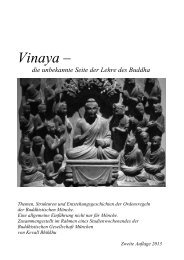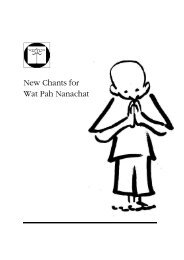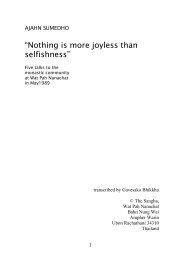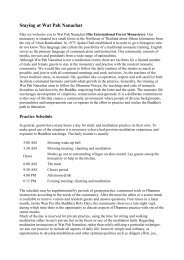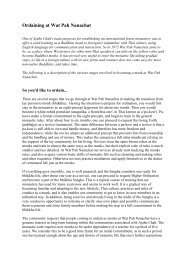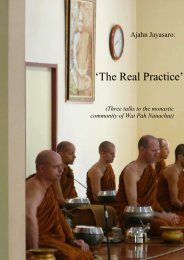Luang Por Liem: The Ways of the Peaceful - Wat Pah Nanachat
Luang Por Liem: The Ways of the Peaceful - Wat Pah Nanachat
Luang Por Liem: The Ways of the Peaceful - Wat Pah Nanachat
You also want an ePaper? Increase the reach of your titles
YUMPU automatically turns print PDFs into web optimized ePapers that Google loves.
and humbleness. <strong>The</strong> same was true for <strong>the</strong> Buddha himself. He<br />
gave importance to <strong>the</strong>se qualities because <strong>the</strong>y bring up beauty in<br />
oneself and cause o<strong>the</strong>rs to appreciate one. We should understand<br />
that gentleness and humbleness are very important qualities for a<br />
samana. <strong>The</strong> expression “adikalyanam” (beautiful in <strong>the</strong><br />
beginning) points to this: one becomes beautiful to look at right<br />
from <strong>the</strong> start. So we should train in being gentle and humble. It is<br />
normal that raw materials need to undergo a process <strong>of</strong> change<br />
and alteration until <strong>the</strong> outcome is a useful product that pleases<br />
people. With no changes and corrections <strong>the</strong> result would be<br />
unsatisfactory. Similarly, if human beings don’t undergo training,<br />
exercise or practice, <strong>the</strong>y are like raw materials. O<strong>the</strong>r people<br />
won’t appreciate <strong>the</strong>m.<br />
As samanas we need to train to calm down and weaken our<br />
worldly behaviour. For example, it is <strong>the</strong> style <strong>of</strong> laypeople to sit<br />
on chairs or around a table. Merely to change this habit to sitting<br />
“pappiab” 20 on <strong>the</strong> floor is already quite difficult for us. It isn’t<br />
impossible, though. After a bit <strong>of</strong> training one can sit on <strong>the</strong> floor<br />
with ease. When I was a layman, I myself had never sat pappiab<br />
or in <strong>the</strong> meditation posture before,. So I was quite stiff and<br />
reluctant with <strong>the</strong>se postures and with all <strong>the</strong> ways <strong>of</strong> paying<br />
respect or bowing. It didn’t go smoothly. <strong>The</strong>se things were<br />
irritating for me, too. But if one relies on a sense <strong>of</strong> patient<br />
endurance and keeps on doing <strong>the</strong>se practices over and over, <strong>the</strong>n<br />
one becomes used to <strong>the</strong>m. One’s way <strong>of</strong> bowing and being<br />
(freedom from anger), avihimsa (non-violence), khanti (patient endurance) and<br />
avirodhana (not straying from righteousness).<br />
20 pappiab (Thai): a semi-cross-legged sitting posture on <strong>the</strong> floor with one<br />
foot pointing behind to <strong>the</strong> back. This is <strong>the</strong> posture that is considered most<br />
appropriate and polite for monks to assume when not meditating, especially<br />
when listening to <strong>the</strong> Dhamma.<br />
54


